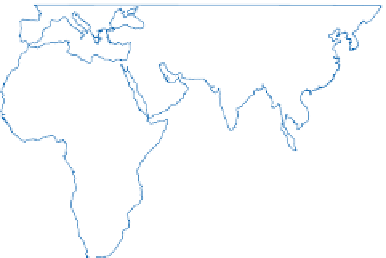Geoscience Reference
In-Depth Information
LONGITUDE
180
160
140
120
100
80
60
40
20
0
20
40
60
80
100
120
140
160
180
45
45
30
30
15
15
0
0
15
15
30
30
45
45
180
160
140
120
100
80
60
40
20
0
20
40
60
80
100
120
140
160
180
LQFKHV
PP
probable inaccuracies. We have just to accept that, apart
from a few areas of intensive observations, we do not know
the precise input of water to the ground surface by snow.
surfaces. Fortunately, water quantities are minute, so that
even large errors are insignificant in relation to the total
precipitation input.
Hail, fog-drip and dew
Hail measurement is even more difficult. Hailstones
possess considerable kinetic energy and many will bounce
out of a conventional gauge, causing underestimation
of their water contribution. The size distribution of hail-
stones can be obtained from a hail pad which measures
the degree of impaction made by the stones. If pads are
left out for known times, the amount of ice and water
equivalent can be found. As hail usually falls from a small
part of a cloud, it is difficult to operate a suitable density
of hailpads to estimate the total contribution of hail.
Fortunately hail is normally insignificant as a precipitation
input to the hydrological cycle, so it is normally recorded
in terms of the number of days with hail.
The water content of fog-drip and dew is small, so
special measurement techniques have to be used. Fog-drip
falls to the surface after contact with leaves or trees, so
trough-shaped rain gauges have been designed to increase
the sampling area and make measurements more accurate.
In principle they work like an ordinary gauge.
The most commonly used instrument for dewfall is
an accurate weighing device. The dewdrops collect on
hygroscopic plates which are attached to a balancing
system to weigh the amount of water collected. All
methods suffer from the basic uncertainty about how
accurately the gauges collect dew, compared with natural
Temporal variations of precipitation
Short-term variability
The variations of rainfall over time are of vital importance
to engineers, environmental scientists and hydrologists.
For example, decisions about bridge size, storm sewer
construction, river quality changes and even flood protec-
tion measures must be taken by experts on the basis of the
expected inputs of precipitation. For this type of decision
a single total is not very informative. We need to know not
only how much rain is likely to fall but over what period
of time. Twenty-five millimetres of rainfall in a day
may not be significant, but if that amount fell in an hour,
or even less, there could be drastic consequences. Surface
run-off might occur, soil erosion might be initiated,
streams might start to swell and flooding might result, as
happened in Boscastle, Cornwall, in August 2004 follow-
ing about 200 mm of rain in just over four hours. Clearly,
the intensity of precipitation is extremely important.
If we monitored a storm, we would normally find that
precipitation intensity - that is, the amount of rainfall per
unit time - varied considerably. Heavy bursts of rain are
normally seen to alternate with relatively quiet periods.
All types of rainfall show these variations; there is rarely
such a thing as steady rain. In fact, it is only when the
source of precipitation is held stationary that we get
























































































































































































































































































































































































































































































































































































































































































































































































































































































































































































































































































































































































